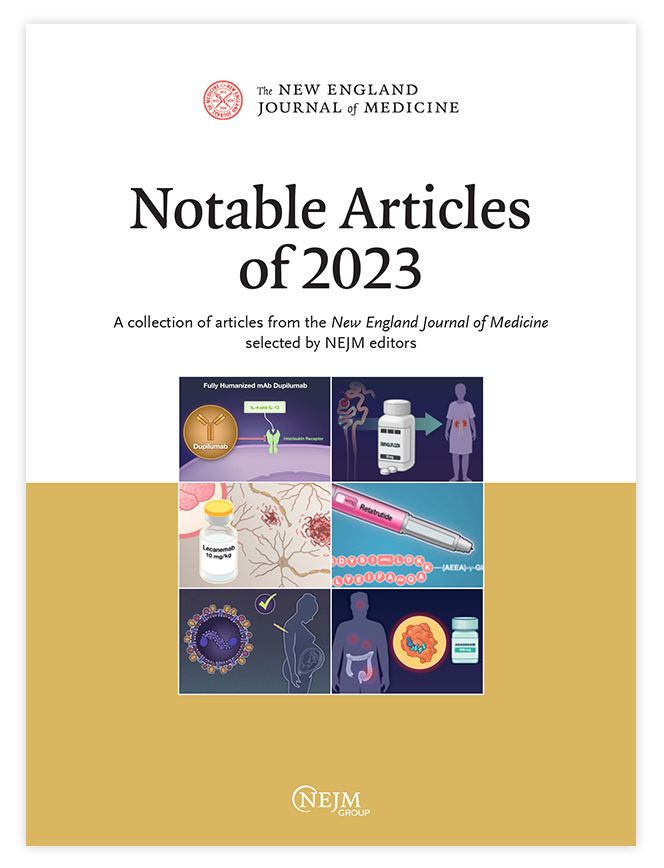Navigational Bronchoscopy or Transthoracic Needle Biopsy for Lung Nodules.
IF 96.2
1区 医学
Q1 MEDICINE, GENERAL & INTERNAL
引用次数: 0
Abstract
BACKGROUND Each year, millions of pulmonary nodules are identified incidentally or through lung cancer screening, and many involve biopsy to distinguish cancer from benign processes. Both navigational bronchoscopy and computed tomography-guided transthoracic needle biopsy are commonly used in patients undergoing biopsies of peripheral pulmonary nodules, but the relative diagnostic accuracy of these two approaches is unclear. METHODS In this multicenter, randomized, parallel-group, noninferiority trial, we assigned patients with an intermediate-risk or high-risk peripheral pulmonary nodule measuring 10 to 30 mm in diameter to undergo navigational bronchoscopy or transthoracic needle biopsy at seven centers across the United States. The primary outcome was diagnostic accuracy, which was defined as the percentage of patients with biopsies that showed a specific diagnosis (cancer or a specific benign condition) that was confirmed to be accurate through 12 months of clinical follow-up (nonferiority margin, 10 percentage points). Secondary outcomes included procedural complications such as the occurrence of pneumothorax. RESULTS Among the 234 patients included in the primary-outcome analysis (5 of whom were lost to follow-up), biopsy resulted in a specific diagnosis that was confirmed to be accurate through month 12 in 94 of 119 patients (79.0%) in the navigational bronchoscopy group and in 81 of 110 patients (73.6%) in the transthoracic needle biopsy group (absolute difference, 5.4 percentage points; 95% confidence interval, -6.5 to 17.2; P = 0.003 for noninferiority; P = 0.17 for superiority). Pneumothorax occurred in 4 of 121 patients (3.3%) in the navigational bronchoscopy group and in 32 of 113 patients (28.3%) in the transthoracic needle biopsy group and led to the placement of a chest tube, hospital admission, or both in 1 patient (0.8%) and 13 patients (11.5%), respectively. CONCLUSIONS The diagnostic accuracy of navigational bronchoscopy was noninferior to that of transthoracic needle biopsy among patients with peripheral pulmonary nodules measuring 10 to 30 mm. (Funded by Medtronic and others; VERITAS ClinicalTrials.gov number, NCT04250194.).导航支气管镜检查或经胸穿刺活检肺结节。
背景:每年,数以百万计的肺结节是偶然或通过肺癌筛查发现的,其中许多涉及活检以区分癌症和良性过程。导航支气管镜检查和计算机断层扫描引导下的经胸穿刺活检常用于行肺周围结节活检的患者,但这两种方法的相对诊断准确性尚不清楚。方法:在这项多中心、随机、平行组、非低效性试验中,我们在美国的7个中心对直径为10 - 30mm的中危或高危肺周围结节患者进行导航支气管镜检查或经胸穿刺活检。主要结果是诊断准确性,其定义为活检显示特定诊断(癌症或特定良性状况)的患者在12个月的临床随访中被证实准确的百分比(非优度,10个百分点)。次要结局包括手术并发症,如气胸的发生。结果在主要结局分析纳入的234例患者中(其中5例失去随访),导航支气管镜组119例患者中有94例(79.0%)活检导致特异性诊断,经胸穿刺活检组110例患者中有81例(73.6%)(绝对差异,5.4个百分点;95%置信区间为-6.5 ~ 17.2;非劣效性P = 0.003;P = 0.17为优势)。导航支气管镜组121例患者中有4例(3.3%)发生气胸,经胸穿刺活检组113例患者中有32例(28.3%)发生气胸,分别导致1例(0.8%)和13例(11.5%)患者放置胸管、住院或两者同时发生气胸。结论在10 ~ 30mm的周围性肺结节患者中,导航支气管镜的诊断准确性不低于经胸穿刺活检。VERITAS ClinicalTrials.gov编号:NCT04250194)。
本文章由计算机程序翻译,如有差异,请以英文原文为准。
求助全文
约1分钟内获得全文
求助全文
来源期刊

New England Journal of Medicine
医学-医学:内科
CiteScore
145.40
自引率
0.60%
发文量
1839
审稿时长
1 months
期刊介绍:
The New England Journal of Medicine (NEJM) stands as the foremost medical journal and website worldwide. With an impressive history spanning over two centuries, NEJM boasts a consistent publication of superb, peer-reviewed research and engaging clinical content. Our primary objective revolves around delivering high-caliber information and findings at the juncture of biomedical science and clinical practice. We strive to present this knowledge in formats that are not only comprehensible but also hold practical value, effectively influencing healthcare practices and ultimately enhancing patient outcomes.
 求助内容:
求助内容: 应助结果提醒方式:
应助结果提醒方式:


